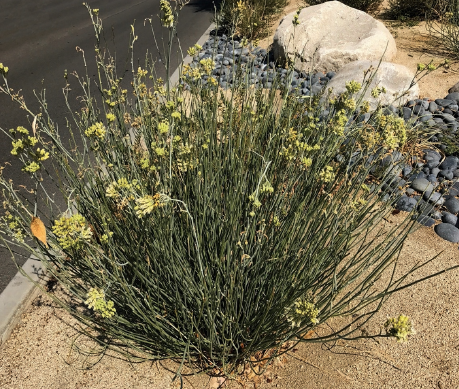
Plant Form: Perennial sub-shrub
Water Use: Low
Mature Size: 3-5 ft. tall & wide
Exposure: Full sun, reflected sun
Bloom Time: Spring (April-May), Summer (June-August), Fall (September-November), Winter (December)
Hardiness: Cold Hardy to 20°F
Native to: California, Arizona, Nevada, Baja California, northwest Mexico
Rush Milkweed is an erect, perennial herb named for its dozens to hundreds of rush-like, leafless, green stems. Small, narrow leaves appear after rain and on new growth, but fall off quickly. Rush Milkweed blooms periodically throughout the year, and is an important food source for Monarch Butterflies, so conservation-minded groups encourage its planting. Fascinating pollen packages are specialized to clip onto legs of insect visitors, and unclip when inserted into another flower. Pairs of distinctive, horn-shaped, 3-inch-long seed pods follow the flowers, filled with many flat seeds that are covered with long, silky plumes. This milkweed oozes a rubber-containing latex when cut or wounded, which can irritate skin. While moderately easy to grow, this desert native is susceptible to aphids and death by root rot if overwatered. Its strong vertical lines make it eye-catching in desert landscapes, in borders, flowerbeds, and butterfly and rock gardens.
THIS MONTH IN YOUR DESERT-SMART LANDSCAPE
Frost is likely on dry, windless, clear nights this month.
- Keep plants watered to help prevent frost damaged
- Wrap irrigation valves and pipes to protect from freezing
- Turn off irrigation timers if it rains
- Apply mulch around plants to retain water and soil, and to feed nutrients into soil with each rain
- Prune roses and summer-blooming deciduous fruit trees
- Don’t prune front-damaged plants until spring growth appears
- Plant bare-root trees and shrubs now through early March
- Mulch around plants and under downspouts with bark, compost, or gravel